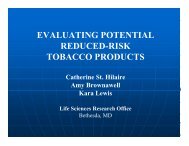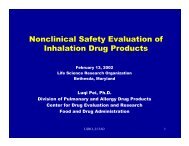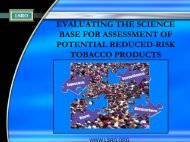2.6 MB PDF file
2.6 MB PDF file
2.6 MB PDF file
Create successful ePaper yourself
Turn your PDF publications into a flip-book with our unique Google optimized e-Paper software.
CONTRIBUTION OF DIETARYCHOLESTEROL AND EGGS TO CHDRISKSByNga Tran, Dr.PH, MPHExponentFood Safety and NutritionAtConference on Cholesterol: Where Science and Public Health Policy IntersectDecember 3, 2008FASEB CampusBethesda, MD
ESTABLISHED RISK FACTORS FOR CORONARY HEARTDISEASEFactorHigh Risk Group(s)Non‐Modifiable Risk FactorsIncreasing ageSexHereditary factorsRace/EthnicityAge 65 and olderMalesPositive family history of heartdisease in a first degree relativeAfrican American race,Mexican Americans, AmericanIndiansAdapted from American Heart Association, “Risk Factors and Coronary Heart Disease: AHA ScientificPosition.” Available at: http://www.americanheart.org/presenter.jhtml?identifier=4726 [accessed March 29,2007].
ESTABLISHED RISK FACTORS FOR CORONARY HEARTDISEASEFactorHigh Risk Group(s)Modifiable, Controllable or Treatable Risk FactorsTobacco SmokeBlood cholesterolBlood pressurePhysical activity levelBody weight/body massDiabetesSmokersHigh levelsHigh blood pressure/hypertensionInactivityOverweight or obeseType 2 diabetes mellitusAlcohol 1 Excessive alcohol consumption 2Adapted from American Heart Association, “Risk Factors and Coronary Heart Disease: AHA Scientific Position.”Available at: http://www.americanheart.org/presenter.jhtml?identifier=4726 [accessed March 29, 2007].1 AHA considers alcohol and stress to be “contributing factors” to risk of CHD. These factors are described as “associatedwith increased risk of cardiovascular disease, but their significance and prevalence have not yet been preciselydetermined.” Furthermore, these factors may have their effect by influencing other established risk factors (AHA 2007).2 Moderate alcohol consumption associated with decreased risk of CHD
BACKGROUND• Emphasis on reducing dietary cholesterol,including limiting egg intake (Kraus et al., 2000)– A large egg contains about 212 mg of cholesterol– ~71% of the Recommended Daily Value (RDV)• Recent epidemiological evidence has not shownassociation between eggs and CHD risk– Greene et al., 2005; Howell et al., 1997; Hu et al., 1999;Kritchevsky and Kritchevsky, 2000; and Song andKerver, 2000, Qureshi et al., 2007.
BACKGROUND• In the Health Professional Follow‐up Study(HPFS) no association was reported betweendietary cholesterol and CHD risk in males– at the highest quintile of dietary cholesterolintake (422mg/day) the relative risk was 1.03 (95%CI: 0.81‐1.32) (Ascherio et al. 1996).• In the Nurses’ Health Study (NHS) a nonsignificantassociation between dietarycholesterol and CHD risk was observed amongfemales– a slight increase in CHD risk was observed for allquintiles of cholesterol intakes (p‐value for trend0.24) (Hu et al. 1997).
STUDY OBJECTIVES• Quantify dietary cholesterol contribution toCHD risks– The egg’s share from its contribution to the totaldietary cholesterol– US females 25+• Risk apportionment technique• Underlying data– CHD risk factors and relative risks (RR’s)– Prevalence of risk factors and food intake
METHOD• Techniques to calculate the proportionate contribution ofcausal factors to the overall excess risk of a disease havebeen well described in the literature– Multi‐factorial risk attribution method or “apportionmenttechnique” ‐‐ in the epidemiological literature.– Armstrong and Theriault, 1995; Chase et al., 1985; Cole andMcMahon, 1971; Enterline, 1983; Grimson, 1987; Robins andGreenland, 1989; Thomas, 1983.• Main idea ‐‐ divide the combined impact of multiple riskfactors into components that can be attributed to theindividual exposures while taking into account theinterrelations between the factors (Land et al, 2001).
METHOD• Application to a public health setting– Barraj LM, Tran NL, Goodman M, Ginevan M. 2008.Perspective: risk apportionment and diseaseintervention strategies. Risk Analysis, 28(2):477‐486– Barraj LM, Tran NL, Mink P. 2008. A comparison ofegg consumption with other modifiable coronaryheart disease lifestyle risk factors: a relative riskapportionment study. Risk Analysis (DOI:10.1111/j.1539‐6924.2008.01149.x)
Barraj LM, Tran NL, Mink P. 2008 . Risk Analysis(DOI: 10.1111/j.1539‐6924.2008.01149.x)FactorsDescriptionEgg consumption1/day versus noneDietSmokingBMI (Overweight)ExercisePoor diet (1 st , 2 nd , & 3 rd quintiles)Good diet (4 th & 5 th quintiles)Current smokersFormer or non‐smoker≥25
METHOD• The “proportional weights model” was determined as abetter model when the additivity assumption of thecombined risk from the multiple causes does not hold• This model estimates assigned share (AS i ) associated withthe i th risk factor (RR i denotes the relative risk associatedwith the i th risk factor):
APPORTIONMENT APPROACH1) Stratify US females 25+ based on common lifestylerisk attributes (diet, obesity, exercise and smoking)2) Within each stratum, apply the apportionment modelto calculate the percent share of CHD risks attributedto the overall diet, relative to the other (obesity,exercise & smoking) risk factors.3) Within each stratum, estimate the fraction of thedietary share of CHD risk that could be assigned todietary cholesterol alone.4) Within each stratum, estimate the fraction of dietarycholesterol from egg and calculate the egg share ofCHD risk.
DATA – LIFESTYLE RISK FACTORS• Prevalence of modifiable CHD risk factors,NHANES 1999‐2002 data• Exercise – responses to questions aboutparticipation in vigorous or moderate physicalactivity over the previous month were recoded asheavy and moderate exercise• Smoking – participants were classified intocurrent smokers and former/non‐smokers• Obesity – participants were classified into BMI>25 or
DATA -- LIFESTYLE RISK FACTORS• Diet Score– Intake based on the 24‐hour consumption data– Replicated the approach used by Stampfer et al 2000• The intakes of trans fat, cereal fiber, marine n‐3 fatty acids, andfolate, glycemic load, and the ratio of polyunsaturated fat tosaturated fat were categorized in quintiles. For eachparticipant, the quintile values for each nutrient were summed(a higher quintile score represented a lower risk), and the sumwas re‐categorized into quintiles.• US females 25+ stratified into groups of similarCHD risk factors (i.e. smoking, exercise, obesity,and diet).
DATA – LIFESTYLE RISK FACTORS ANDRELATIVE RISKS• The relative risks (RR’s) were derived mainlyfrom the Nurses Health Study (NHS)– Multivariate‐adjusted RR’s ‐ both studies adjusted forpotential confounding factors in addition to age.– Minimize the effect of potential differences in studydesign and population selection on RR estimates
Factor Description RR ReferenceDietPoor diet (1 st , 2 nd , & 3 rdquintiles) v.good diet (4 th & 5 th quintiles)Smoking Current smokers v.Former or non‐smokerObesity BMI ≥25 v.
RESULTS -- LIFESTYLE RISK FACTORS• US females 25+ (>82%; >77 million individuals)with one or more of the four lifestyle CHD riskfactor• The diet contribution to CHD risk varieddepending upon an individual health status andthe presence/absence of other CHD risk factors– On average poor diet contributes about 20% of theCHD risk among US females 25+
DATA – DIETARY FACTORS• 24‐hr recall data from NHANES 1999‐2002 wereused to calculate current daily intakes ofnutrients, dietary cholesterol from all foodsources and the fraction from egg foods.• Average daily intake of these nutrients, and theirassociated RRs were extrapolated from thequintiles of intakes and RRs reported from theNHS study
DATA – DIETARY FACTORS ANDESTIMATED RR’s• Publications– Impact of the “total” diet on CHD risk (3)– Impact of “whole foods” on CHD risk (4)– Impact of specific macro/micro nutrients, fats,cholesterol, etc on CHD risk (12)• Ten dietary risk factors were included in thedietary risk apportionment model:– Cholesterol, marine n‐3 fatty acids, PUFA,MUFA, Trans Fat, ALA, dietary fiber, folate,Vitamin B6 and Vitamin C.
RATIONALE FOR INCLUSION• Although the association between dietary cholesteroland CHD is not statistically significant in the NHS, itis a listed risk factor by the AHA and a focus of thisstudy• The association between CHD and low intake ofmarine n‐3 fatty acid, PUFA, folate, vitamin B6 anddietary fiber, and high intake of trans‐fat among NHSsubjects were statistically significant in the NHS• While not statistically significant for non‐fatal CHD,the association between fatal CHD and low ALAintake was significant in the NHS
RATIONALE• The associations between CHD and MUFAand vitamin C were not statisticallysignificant, but there was an inverserelationship between increasing intake andCHD risk• Saturated fat was not included ‐‐ Noassociation with CHD was observed in theNHS subjects (Oh et al 2005)– RR’s: 1, 0.94, 0.96, 1.04, and 0.97 for the 1 st to 5 thquintiles of exposure as % energy, respectively
RESULTS• The average cholesterol intake among the majority (82%)of US females 25+ is 227.7 mg/day.• The dietary cholesterol share of CHD risk, relative to theother dietary factors (i.e., trans fat, MUFA, PUFA, marinen‐3FA, ALA, dietary fiber, vitamins B6 and C, and folate)and lifestyle risk factors (i.e., obesity, inactivity, smoking)is 1.5%.• As a sensitivity analysis, when ignoring risk contributionby other dietary factors an upper bound estimate of 1.9%was derived.• 20‐ 28% of dietary cholesterol are from eggs, thus the egg’sshare is 0.40% ‐ 0.47%
CONCLUSIONS• CHD risk is expected to be influenced byindividual underlying risk factors (bothmodifiable and non‐modifiable factors,including genetics).• Egg cholesterol contribution to CHD risk,relative to other dietary and non‐dietarylifestyle risk factors, is small (0.40 – 0.47%).
CONCLUSIONS• Potential health benefits of eggs in context of lifestages• Lutein, zeaxanthin, choline, protein• The elderly, CHD risk compared to potentialhealth benefits from eating eggs (e.g. AMD,sarcopenia)• Childbearing age females, egg’s s share of CHDrisk relative to other CHD risk factor and incomparison to benefits to fetuses (e.g. NTD, braindevelopment)
Tran NL, Barraj LM. 2008. Dietary cholesterolcontribution to coronary heart disease riskrelative to other dietary and modifiable riskfactors. (In Submission)








